High-Antimicrobial Gallium-Doped Zinc Oxide Thin Films on Bio-Based Poly(Ethylene Furanoate) Substrates for Food Packaging Application
Abstract
1. Introduction
2. Experimental
2.1. Materials
2.2. Fabrication of PEF/GZO Composite Thin Films
2.3. Films Characterization
3. Results and Discussion
3.1. Optical and Surface Properties
3.2. Water Vapor and Gas Barrier Properties
3.3. Antimicrobial Properties
3.4. Mechanical Properties
4. Conclusions
Author Contributions
Funding
Institutional Review Board Statement
Data Availability Statement
Conflicts of Interest
References
- Chen, Y.; Awasthi, A.K.; Wei, F.; Tan, Q.; Li, J. Single-use plastics: Production, usage, disposal, and adverse impacts. Sci. Total Environ. 2020, 752, 141772. [Google Scholar] [CrossRef] [PubMed]
- Viera, J.S.C.; Marques, M.R.C.; Nazareth, M.C.; Jimenez, P.C.; Castro, I.B. On replacing single-use plastic with so-called biodegradable ones: The case with straws. Environ. Sci. Policy 2020, 106, 177–181. [Google Scholar] [CrossRef]
- Haque, A.; Naebe, M. Sustainable biodegradable denim waste composites for potential single-use packaging. Sci. Total Environ. 2022, 809, 809. [Google Scholar] [CrossRef] [PubMed]
- Jin, M.; Wang, X.; Ren, T.; Wang, J.; Shan, J. Microplastics contamination in food and beverages: Direct exposure to humans. J. Food Sci. 2021, 86, 2816–2837. [Google Scholar] [CrossRef]
- Qiu, S.; Sun, J.; Li, H.; Gu, X.; Fei, B.; Zhang, S. A green way to simultaneously enhance the mechanical, flame retardant and anti-ultraviolet aging properties of polylactide composites by the incorporation of tannic acid derivatives. Polym. Degrad. Stabil. 2022, 196, 109831. [Google Scholar] [CrossRef]
- De, D.; Sai, M.S.N.; Aniya, V.; VineetSatyavathi, B. Strategic biorefinery platform for green valorization of agro-industrial residues: A sustainable approach towards biodegradable plastics. J. Clean. Prod. 2020, 290, 125184. [Google Scholar] [CrossRef]
- Mensitieri, G.; Maio, E.D.; Buonocore, G.G.; Nedi, I.; Oliviero, M.; Sansone, L.; Iannace, S. Processing and shelf life issues of selected food packaging materials and structures from renewable resources. Trends Food Sci. Tech. 2011, 22, 72–80. [Google Scholar] [CrossRef]
- Deng, J.; Zhu, E.Q.; Xu, G.F.; Naik, N.; Murugadoss, V.; Ma, M.G.; Guo, Z.; Shi, Z.J. Overview of renewable polysaccharide-based composites for biodegradable food packaging applications. Green Chem. 2022, 24, 480–492. [Google Scholar] [CrossRef]
- Steven, K.B.; Johannes, E.L.; Brian, E.K.; Christopher, R.M.; Robert, M.K.; William, J.K. Chain Mobility, Thermal, and Mechanical Properties of Poly(ethylene furanoate) Compared to Poly(ethylene terephthalate). Macromolecules 2014, 47, 1383–1391. [Google Scholar]
- Steven, K.B.; Oguz, K.; Johnson, J.R.; Robert, M.K.; William, J.K. Oxygen sorption and transport in amorphous poly(ethylene furanoate). Polymer 2014, 55, 4748–4756. [Google Scholar]
- Poulopoulou, N.; Pipertzis, A.; Kasmi, N.; Bikiaris, D.N.; Papageorgiou, D.G.; Floudas, G.; Papageorgiou, G.Z. Green polymeric materials: On the dynamic homogeneity and miscibility of furan-based polyester blends. Polymer 2019, 174, 187–199. [Google Scholar] [CrossRef]
- Zhang, X.; Wang, J.; Dong, Y.; Wang, Q.; Zhu, J. Self-healing and biodegradable copolyesters synthesized from 2,5-furandicarboxylic acid applied as human skin. J. Appl. Polym. Sci. 2022, 139, e52627. [Google Scholar]
- Zhu, C.; Zhou, J.; Li, J.; Yang, Y.; Xu, W.; Zhong, L.; Wang, J.; Zhu, J.; Song, W. Room temperature sputtering deposition of high-haze Ga-doped ZnO transparent conductive thin films on self-textured bio-based poly(ethylene 2, 5-furandicarboxylate) substrates. Ceram. Int. 2017, 44, 369–373. [Google Scholar] [CrossRef]
- Forestier, E.; Combeaud, C.; Guigo, N.; Corvec, G.; Pradille, C.; Sbirrazzuoli, N.; Billon, N. Comparative Analysis of the Mechanical Behaviour of PEF and PET Uniaxial Stretching Based on the Time/Temperature Superposition Principle. Polymers 2021, 13, 3295. [Google Scholar] [CrossRef]
- Lightfoot, J.C.; Buchard, A.; Castro-Dominguez, B.; Parker, S.C. Comparative Study of Oxygen Diffusion in Polyethylene Terephthalate and Polyethylene Furanoate Using Molecular Modeling: Computational Insights into the Mechanism for Gas Transport in Bulk Polymer Systems. Macromolecules 2021, 55, 498–510. [Google Scholar] [CrossRef]
- Kim, T.; Bamford, J.; Gracida-Alvarez, U.R.; Benavides, P.T. Life Cycle Greenhouse Gas Emissions and Water and Fossil-Fuel Consumptions for Polyethylene Furanoate and Its Coproducts from Wheat Straw. ACS Sustain. Chem. Eng. 2022, 10, 2830–2843. [Google Scholar] [CrossRef]
- Ni, Y.; Shi, S.; Li, M.; Zhang, L.; Yang, C.; Du, T.; Wang, S.; Nie, H.; Sun, J.; Zhang, W.; et al. Visible light responsive, self-activated bionanocomposite films with sustained antimicrobial activity for food packaging. Food Chem. 2021, 362, 130201. [Google Scholar] [CrossRef]
- Andrade, J.; Gonzalez-Martinez, C.; Chiralt, A. Antimicrobial PLA-PVA multilayer films containing phenolic compounds. Food Chem. 2022, 375, 131861. [Google Scholar] [CrossRef]
- Hosseini, S.F.; Kaveh, F.; Schmid, M. Facile fabrication of transparent high-barrier poly(lactic acid)-based bilayer films with antioxidant/antimicrobial performances. Food Chem. 2022, 384, 132540. [Google Scholar] [CrossRef]
- Pan, Y.; Cai, P.; Xie, Y. Cellulose-based antimicrobial films incroporated with ZnO nanopillars on surface as biodegradable and antimicrobial packaging. Food Chem. 2022, 368, 130784. [Google Scholar]
- Sallak, N.; Moghanjoughi, A.M.; Ataee, M.; Anvar, A.; Golestan, L. Antimicrobial biodegradable film based on corn starch/Satureja khuzestanica essential oil/Ag–TiO2 nanocomposites. Nanotechnology 2021, 32, 405703. [Google Scholar] [CrossRef] [PubMed]
- Zhang, P.; Luo, S.; Gao, D. Effects of poly(butylene adipate-co-terephthalate) /TiO2 nanocomposite antimicrobial films on chilled pork quality. Packag. Technol. Sci. 2021, 34, 709–715. [Google Scholar] [CrossRef]
- Sosa, S.M.; Huertas, R.; Pereira, V.J. Combination of Zinc Oxide Photocatalysis with Membrane Filtration for Surface Water Disinfection. Membranes 2023, 13, 56. [Google Scholar] [CrossRef] [PubMed]
- Dai, L.; Li, R.; Liang, Y.; Liu, Y.; Zhang, W.; Shi, S. Development of Pomegranate Peel Extract and Nano ZnO Co-Reinforced Polylactic Acid Film for Active Food Packaging. Membranes 2022, 12, 1108. [Google Scholar] [CrossRef] [PubMed]
- Xie, Y.; He, Y.; Irwin, P.L.; Jin, T.; Shi, X. Antibacterial activity and mechanism of action of zinc oxide nanoparticles against campylobacter jejuni. Appl. Environ. Microbiol. 2011, 77, 2325–2331. [Google Scholar] [CrossRef]
- Alyamani, A.A.; Albukhaty, S.; Aloufi, S.; AlMalki, F.A.; Al-Karagoly, H.; Sulaiman, G.M. Green Fabrication of Zinc Oxide Nanoparticles Using Phlomis Leaf Extract: Characterization and In Vitro Evaluation of Cytotoxicity and Antibacterial Properties. Molecules 2021, 26, 6140. [Google Scholar] [CrossRef]
- Ray, P.C.; Yu, H.; Fu, P.P. Toxicity and environmental risks of nanomaterials: Challenges and future needs. J. Environ. Sci. Health Part C 2009, 27, 1–35. [Google Scholar] [CrossRef]
- Valerini, D.; Tammaro, L.; Benedetto, F.D.; Vigliotta, G.; Capodieci, L.; Terzi, R.; Rizzo, A. Aluminum-doped zinc oxide coatings on polylactic acid films for antimicrobial food packaging. Thin Solid Film. 2018, 645, 187–192. [Google Scholar] [CrossRef]
- Hassan, I.A.; Sathasivam, S.; Nair, S.P.; Claire, J. CarmaltAntimicrobial properties of copper-doped ZnO catings under darkness and white light illumination. ACS Omega 2017, 2, 4556–4562. [Google Scholar] [CrossRef]
- Zhu, C.; Li, J.; Yang, Y.; Lan, P.; Huang, J.; Lu, Y.; Tan, R.; Dai, N.; Song, W. Tailoring the resonance wavelength and loss of highly Ga doped ZnO plasmonic materials by varied doping content and substrate temperature. Thin Solid Film. 2016, 605, 95–101. [Google Scholar] [CrossRef]
- Wang, S.; Lee, R.J.; Mathias, C.J.; Green, M.A.; Low, P.S. Synthesis, purification, and tumor cell uptake of 67Ga-deferoxamine--folate, a potential radiopharmaceutical for tumor imaging. Bioconjug Chem. 1996, 7, 56–62. [Google Scholar] [CrossRef]
- Al-Nahhas, A.; Win, Z.; Szyszko, T.; Singh, A.; Khan, S.; Rubello, D. What can gallium-68 PET add to receptor and molecular imaging? Eur. J. Nucl. Med. Mol. Imaging 2007, 34, 1897–1901. [Google Scholar] [CrossRef]
- Bilezikian, J.P. Management of acute hypercalcemia. N. Engl. J. Med. 1992, 326, 1196–1203. [Google Scholar]
- Wang, Y.; Han, B.; Xie, Y.; Wang, H.; Wang, R.; Xia, W.; Li, H.; Sun, H. Combination of gallium(iii) with acetate for combating antibiotic resistant Pseudomonas aeruginosa. Chem. Sci. 2019, 10, 6099–6106. [Google Scholar] [CrossRef]
- Zhu, C.; Li, J.; Yang, Y.; Huang, J.; Lu, Y.; Tan, R.; Dai, N.; Song, W. Zn-aided defect control for ultrathin GZO films with high carrier concentration aiming at alternative plasmonic metamaterials. Phys. Status Solidi A 2015, 212, 1713–1718. [Google Scholar] [CrossRef]
- Piedade, A.P.; Pinho, A.C.; Branco, R.; Morais, P.V. Evaluation of antimicrobial activity of ZnO based nanocomposites for the coating of non-critical equipment in medical-care facilities. Appl. Surf. Sci. 2020, 513, 145818. [Google Scholar] [CrossRef]
- Zhang, X.; Zhang, Q.; Yan, T.; Jiang, Z.; Zhang, X.; Zuo, Y.Y. Quantitatively Predicting Bacterial Adhesion Using Surface Free Energy Determined with a Spectrophotometric Method. Environ. Sci. Technol. 2015, 49, 6164–6171. [Google Scholar] [CrossRef]
- Genzer, J.; Efimenko, K. Recent developments in superhydrophobic surfaces and their relevance to marine fouling: A review. Biofouling 2006, 22, 339–360. [Google Scholar] [CrossRef]
- Ono, E.Y.S.; Sasaki, E.Y.; Hashimoto, E.H.; Hara, L.N.; Corrêa, B.; Itano, E.N.; Sugiura, T.; Ueno, Y.; Hirooka, E.Y. Post-harvest storage of corn: Effect of beginning moisture content on mycoflora and fumonisin contamination. Food Addit. Contam. 2002, 19, 1081–1090. [Google Scholar] [CrossRef]
- Liu, J.; Rades, T.; Grohganz, H. The influence of moisture on the storage stability of co-amorphous systems. Int. J. Pharm. 2021, 605, 120802. [Google Scholar] [CrossRef]
- Dogan, H.; Koral, M.; Inan, T.Y. Ag/Zn Zeolite Containing Antibacterial Coating for Food-Packaging Substrates. J. Plast. Film Sheet. 2009, 25, 207–220. [Google Scholar] [CrossRef]
- Montazer, M.; Harifi, T. New approaches and future aspects of antibacterial food packaging: From nanoparticles coating to nanofibers and nanocomposites, with foresight to address the regulatory uncertainty. In Food Packaging; Academic Press: Cambridge, MA, USA, 2017; pp. 533–565. [Google Scholar]
- Xu, X.; Chen, D.; Yi, Z.; Jiang, M.; Wang, L.; Zhou, Z.; Fan, X.; Wang, Y.; Hui, D. Antimicrobial mechanism based on H2O2 generation at oxygen vacancies in ZnO crystals. Langmuir 2013, 29, 5573–5580. [Google Scholar] [CrossRef] [PubMed]
- Correia, F.C.; Bundaleski, N.; Teodoro, O.M.N.D.; Correia, M.R.; Rebouta, L.; Mendes, A.; Tavares, C.J. XPS analysis of ZnO:Ga films deposited by magnetron sputtering: Substrate bias effect. Appl. Surf. Sci. 2018, 458, 1043–1049. [Google Scholar] [CrossRef]
- Carvalho, P.; Sampaio, P.; Azevedo, S.; Vaz, C.; Espinós, J.P.; Teixeira, V.; Carneiro, J.O. Influence of thickness and coatings morphology in the antimicrobial performance of zinc oxide coatings. Appl. Surf. Sci. 2014, 307, 548–557. [Google Scholar] [CrossRef]
- Choi, H.J.; Pammi, S.V.N.; Park, B.J.; Eom, J.H.; An, H.; Kim, H.Y.; Kim, M.; Seol, D.; Kim, Y.; Yoon, S.G. Resistance against water and acid water (pH = 4.0) via Al-doped ZnO thin films for environmentally friendly glass panels. J. Alloy. Compd. 2017, 719, 271–280. [Google Scholar] [CrossRef]
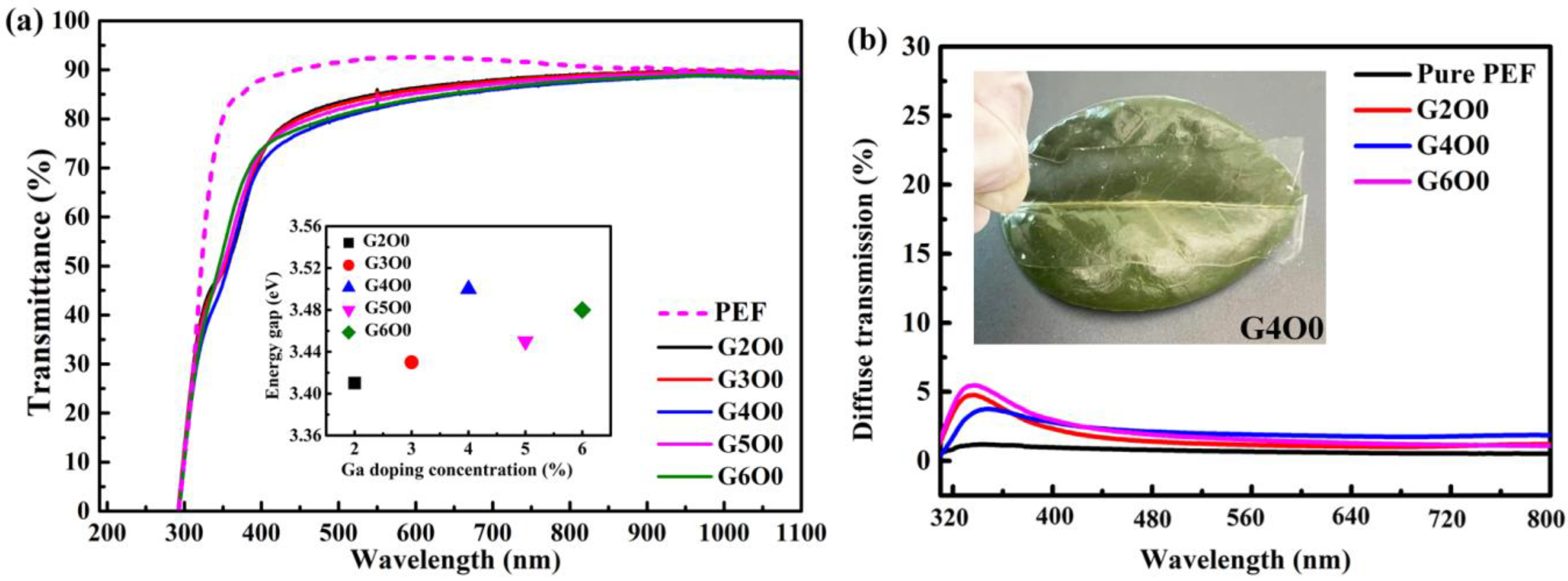
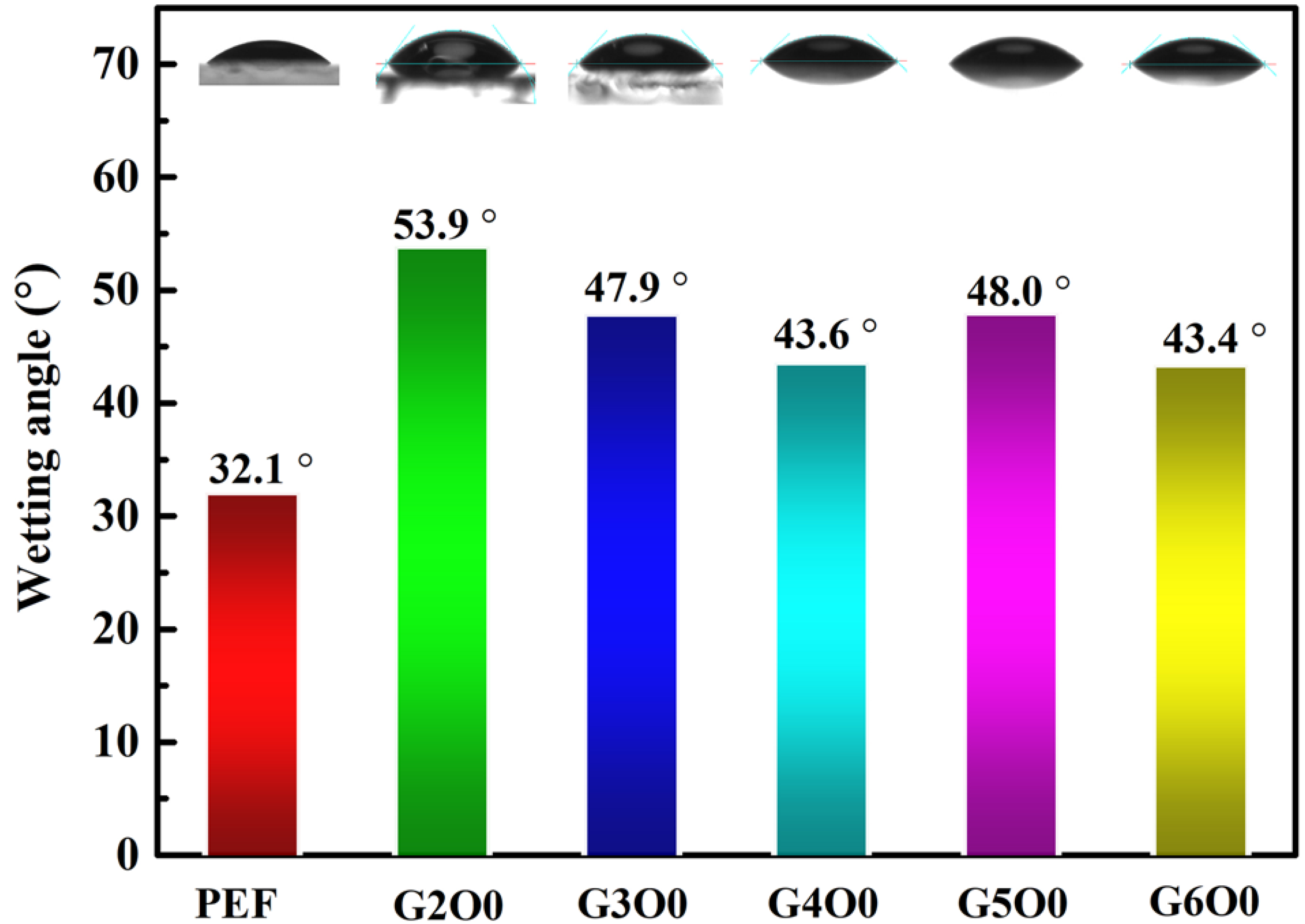
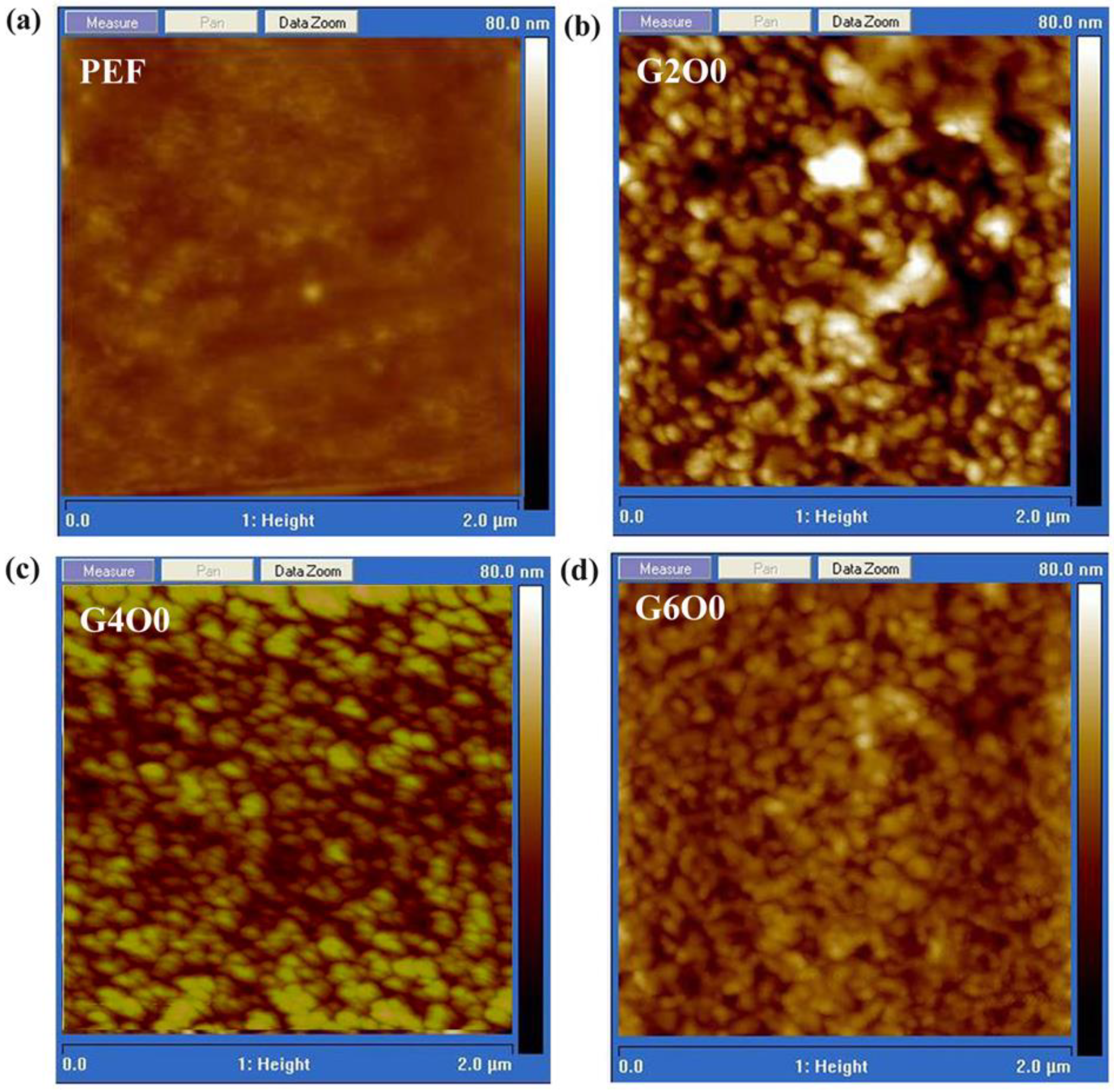
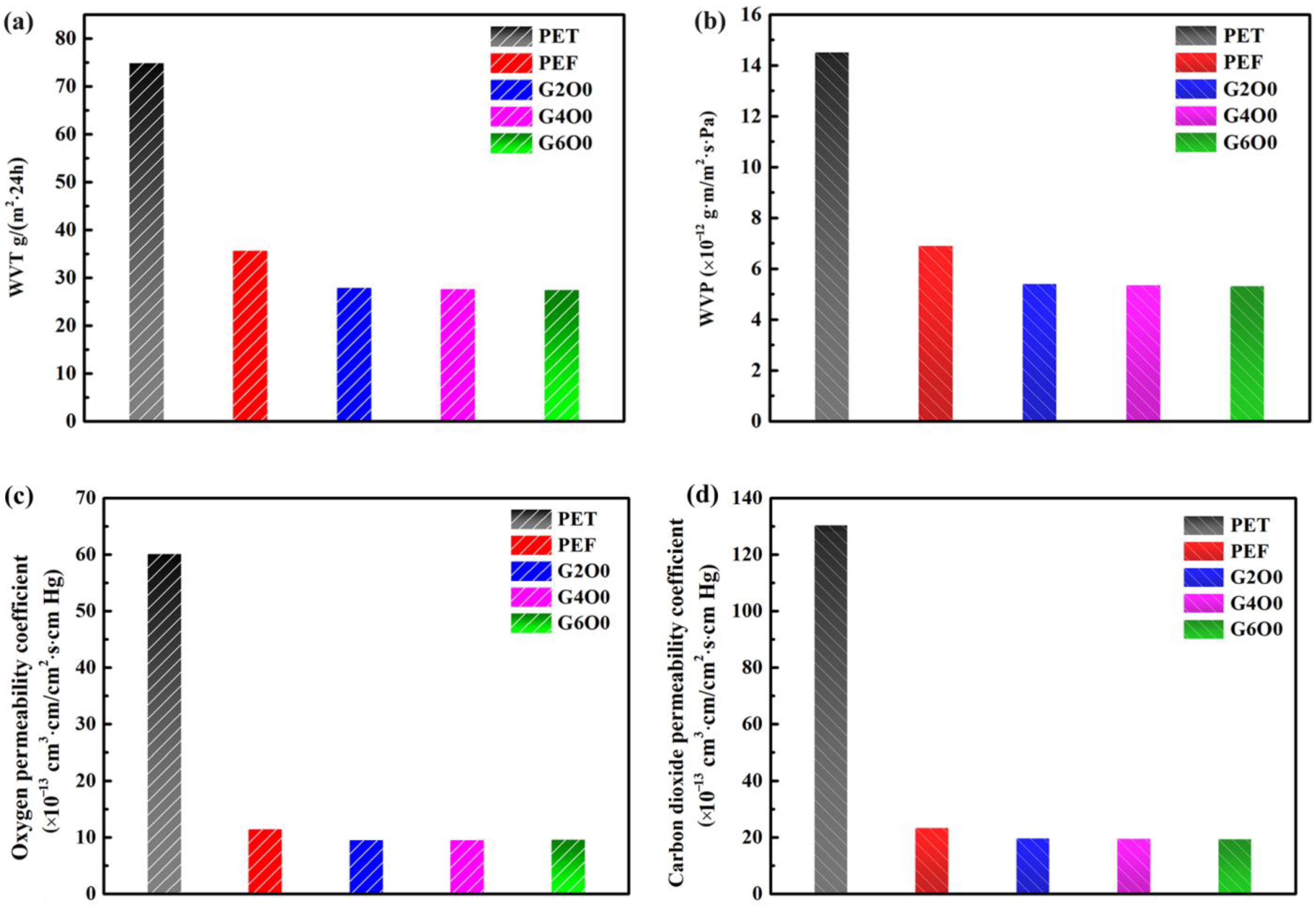
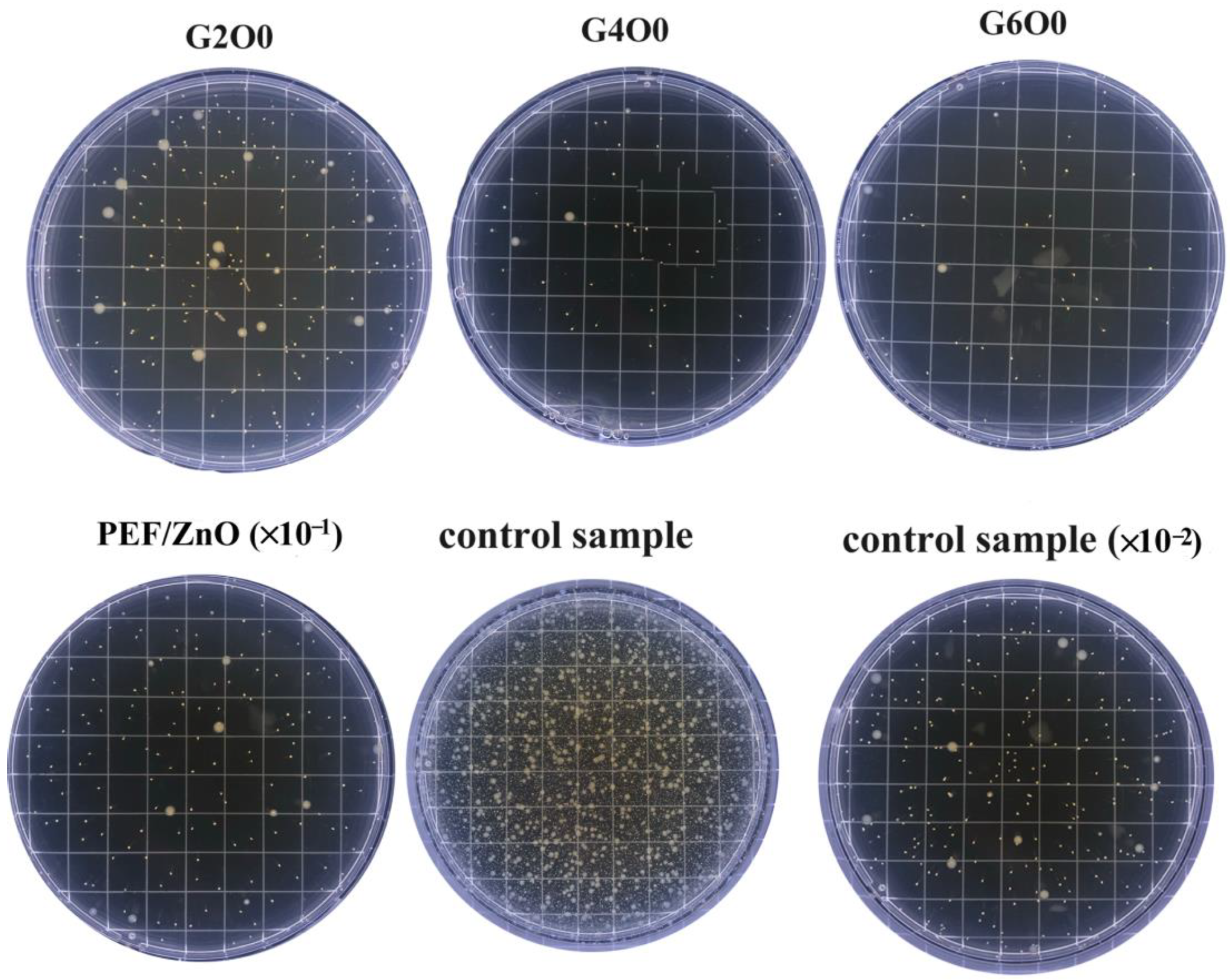
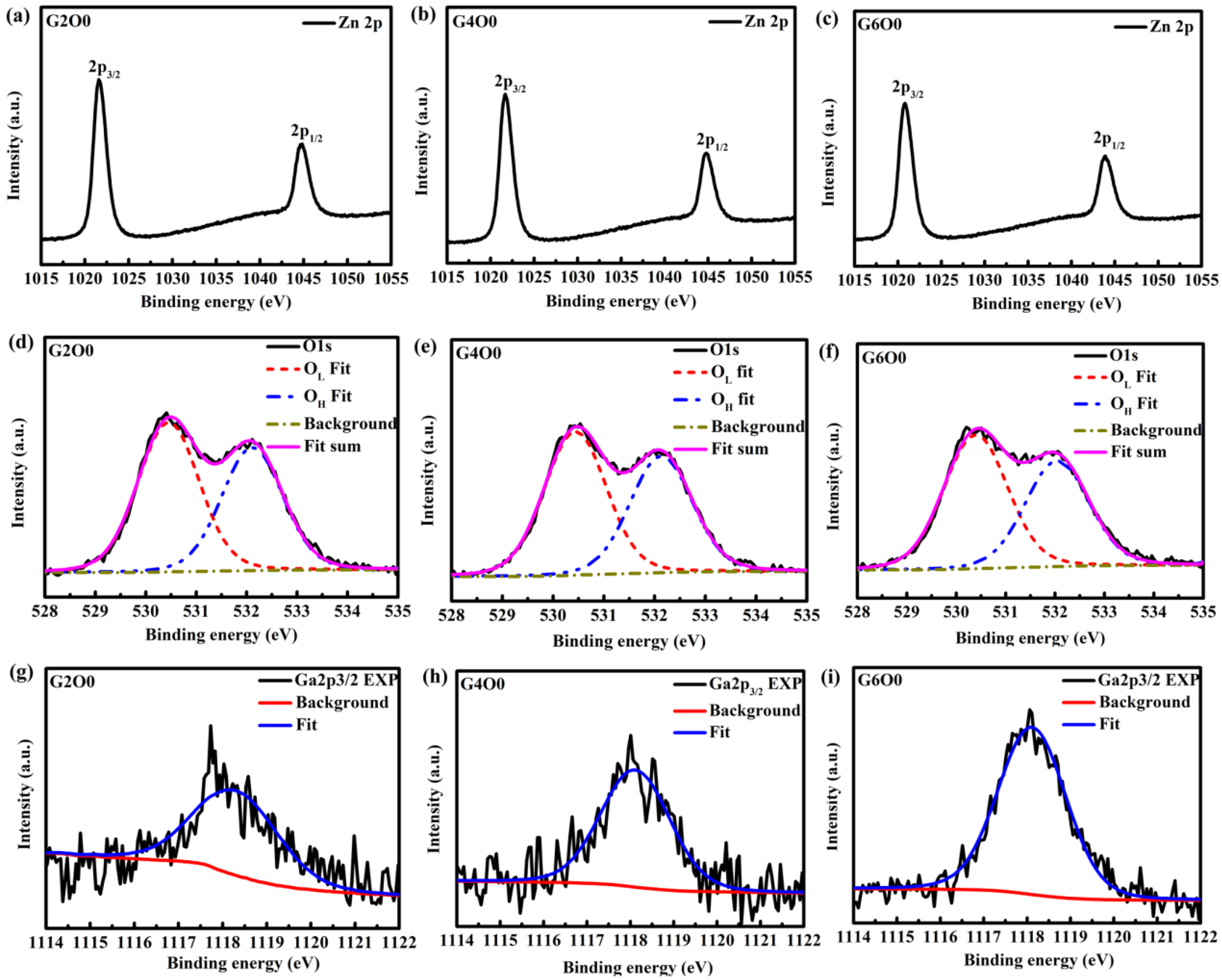
| Samples | Number of Colonies in the Eluent (CFU/mL) | Bacteriostatic Rate/% |
|---|---|---|
| PEF/ZnO G2O0 | 1810 252 | 94.14 99.18 |
| G4O0 | 69 | 99.78 |
| G6O0 | 46 | 99.85 |
| PEF (control) | 3.09 × 104 | ~ |
| Samples | O 1s | Zn2p3/2 (eV) | Ga 2p3/2 (eV) | |
|---|---|---|---|---|
| OL (eV) | OH (eV) | |||
| G2O0 | 530.4 | 532.1 | 1021.7 | 1118.3 |
| G4O0 | 530.5 | 532.1 | 1021.8 | 1118.2 |
| G6O0 | 530.4 | 532.0 | 1021.9 | 1118.1 |
| Samples | Percent of Zn2p | Percent of OL | Percent of OH | Percent of Ga2p | Atomic Ratio of | VO (%) |
|---|---|---|---|---|---|---|
| (%) | (%) | (%) | (%) | OL/(Zn2p + Ga2p) | ||
| G2O0 | 40.64% | 32.01% | 26.37% | 0.98% | 0.769 | 23.1% |
| G4O0 | 40.16% | 32.32% | 25.58% | 1.94% | 0.768 | 23.2% |
| G6O0 | 39.65% | 32.23% | 25.47% | 2.65% | 0.762 | 23.8% |
| Sample | Tensile Strength (M Pa) | Young’s Modulus (G Pa) | Breakage Elongation (%) |
|---|---|---|---|
| PET | 62 | 1.91 | 108 |
| PEF | 83 | 2.85 | 5.1 |
| G2O0 | 86 | 2.91 | 4.9 |
| G4O0 | 84 | 2.87 | 5.0 |
| G6O0 | 87 | 2.92 | 5.0 |
Disclaimer/Publisher’s Note: The statements, opinions and data contained in all publications are solely those of the individual author(s) and contributor(s) and not of MDPI and/or the editor(s). MDPI and/or the editor(s) disclaim responsibility for any injury to people or property resulting from any ideas, methods, instructions or products referred to in the content. |
© 2023 by the authors. Licensee MDPI, Basel, Switzerland. This article is an open access article distributed under the terms and conditions of the Creative Commons Attribution (CC BY) license (https://creativecommons.org/licenses/by/4.0/).
Share and Cite
Zhu, C.; Ye, D.; Zhou, T.; Cui, Y.; Yin, J. High-Antimicrobial Gallium-Doped Zinc Oxide Thin Films on Bio-Based Poly(Ethylene Furanoate) Substrates for Food Packaging Application. Membranes 2023, 13, 239. https://doi.org/10.3390/membranes13020239
Zhu C, Ye D, Zhou T, Cui Y, Yin J. High-Antimicrobial Gallium-Doped Zinc Oxide Thin Films on Bio-Based Poly(Ethylene Furanoate) Substrates for Food Packaging Application. Membranes. 2023; 13(2):239. https://doi.org/10.3390/membranes13020239
Chicago/Turabian StyleZhu, Chaoting, Danling Ye, Tianqi Zhou, Yashuang Cui, and Jianbing Yin. 2023. "High-Antimicrobial Gallium-Doped Zinc Oxide Thin Films on Bio-Based Poly(Ethylene Furanoate) Substrates for Food Packaging Application" Membranes 13, no. 2: 239. https://doi.org/10.3390/membranes13020239
APA StyleZhu, C., Ye, D., Zhou, T., Cui, Y., & Yin, J. (2023). High-Antimicrobial Gallium-Doped Zinc Oxide Thin Films on Bio-Based Poly(Ethylene Furanoate) Substrates for Food Packaging Application. Membranes, 13(2), 239. https://doi.org/10.3390/membranes13020239






